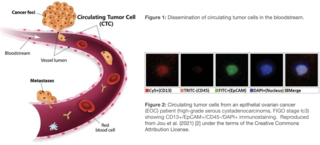Detection of Circulating Tumor Cells using the SPECTRA Light Engine
Detection of circulating tumor cells (CTC) is in widespread development as a noninvasive “liquid biopsy” for early-stage cancer diagnosis. CTCs are cells that circulate in the blood and the lymphatic system after becoming detached from a primary tumor (Figure 2). The main challenge in detection of CTCs is their extremely low abundance. The critical level for diagnosis is about 1 CTC per milliliter of blood against a background of millions of white cells and billions of red cells. Detection of CTCs is accomplished by cellular enrichment, using one of several strategies followed by immunofluorescence discrimination of CTCs from normal blood cells (1).
Lumencor Light Engines provide illumination for immunofluorescence imaging in many commercial CTC detection systems currently undergoing development and validation. One such lighting system, recently described by Jou and co-workers (2), uses a microfluidic device with embedded streptavidin-coated nanopillar arrays to capture target cells preincubated with biotinylated anti-EpCAM and anti-N-cadherin antibodies. Using high-performance, solid-state illumination from a SPECTRA Light Engine, CTCs are identified as FITC–EpCAM positive/TRITC–CD45 negative/DAPI positive. Increased specifi city can be achieved by expanding the multiplex immunostaining panel with the cancer stem cell specific marker CD13 (Figure 2). The entire process of CTC enrichment, immunostaining, slide scanning, image analysis and cell classification is automated, resulting in improved reproducibility and increased throughput compared to protocols involving manual processing.




